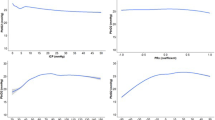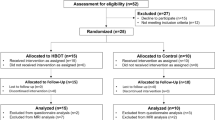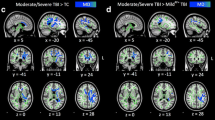Abstract
Purpose
Traumatic brain injury (TBI) is a leading cause of morbidity and mortality in children. Preventing secondary injury by controlling physiological parameters (e.g. intracranial pressure [ICP], cerebral perfusion pressure [CPP] and brain tissue oxygen [PbtO2]) has a potential to improve outcome. Low PbtO2 is independently associated with poor clinical outcomes in both adults and children. However, no studies have investigated associations between low PbtO2 and neuropsychological and behavioural outcomes following severe pediatric TBI (pTBI).
Methods
We used a quasi-experimental case-control design to investigate these relationships. A sample of 11 TBI patients with a Glasgow Coma Scale score ≤8 who had PbtO2 and ICP monitoring at the Red Cross War Memorial Children’s Hospital underwent neuropsychological evaluation ≥1 year post-injury. Their performance was compared to that of 11 demographically matched healthy controls. We then assigned each TBI participant into one of two subgroups, (1) children who had experienced at least one episode of PbtO2 ≤ 10 mmHg or (2) children for whom PbtO2 > 10 mmHg throughout the monitoring period, and compared their results on neuropsychological evaluation.
Results
TBI participants performed significantly more poorly than controls in several cognitive domains (IQ, attention, visual memory, executive functions and expressive language) and behavioural (e.g. externalizing behaviour) domains. The PbtO2 ≤ 10 mmHg group performed significantly worse than the PbtO2 > 10 mmHg group in several cognitive domains (IQ, attention, verbal memory, executive functions and expressive language), but not on behavioural measures.
Conclusion
Results demonstrate that low PbtO2 may be prognostic of not only mortality but also neuropsychological outcomes.
Similar content being viewed by others
Notes
References
Chambers IR, Jones PA, Lo TYM, Forsyth RJ, Fulton B, Andrews PJD, Mendelow AD, et al. (2006) Critical thresholds of intracranial pressure and cerebral perfusion pressure related to age in paediatric head injury. J Neurol Neurosurg Psychiatry 77(2):234–240. doi:10.1136/jnnp.2005.072215
Chesnut RM, Marshall LF, Klauber MR, Blunt BA, Baldwin N, Eisenberg HM, Jane JA, et al. (1993) The role of secondary brain injury in determining outcome from severe head injury. The Journal of Trauma 34(2):216–222
Downard C, Hulka F, Mullins RJ, Piatt J, Chesnut R, Quint P, Mann NC (2000) Relationship of cerebral perfusion pressure and survival in pediatric brain-injured patients. The Journal of Trauma 49(4):658–659
Figaji AA, Zwane E, Thompson C, Fieggen AG, Argent AC, Le Roux PD, Peter JC (2009b) Brain tissue oxygen tension monitoring in pediatric severe traumatic brain injury. Part 2: relationship with clinical, physiological, and treatment factors. Childs Nerv Syst 25(10):1335–1343. doi:10.1007/s00381-009-0821-y
Figaji AA, Zwane E, Fieggen AG, Peter JC, Leroux PD (2008) Acute clinical grading in pediatric severe traumatic brain injury and its association with subsequent intracranial pressure, cerebral perfusion pressure, and brain oxygenation. Neurosurg Focus 25(4):E4. doi:10.3171/FOC.2008.25.10.E4
Tang ME, Lobel DA (2009) Severe traumatic brain injury: maximizing outcomes. Mt Sinai J Med 76(2):119–128. doi:10.1002/MSJ
Bass JL, Corwin M, Gozal D, Moore C, Nishida H, Parker S, Schonwald A, et al. (2004) The effect of chronic or intermittent hypoxia on cognition in childhood: a review of the evidence. Pediatrics 114(3):805–816. doi:10.1542/peds.2004-0227
Hopkins RO, Haaland KY (2004) Neuropsychological and neuropathological effects of anoxic or ischemic induced brain injury. J Int Neuropsychol Soc 10(7):957–961
Rohlwink UK, Figaji AA (2010) Methods of monitoring brain oxygenation. Childs Nerv Syst 26(4):453–464. doi:10.1007/s00381-009-1033-1
Greve MW, Zink BJ (2009) Pathophysiology of traumatic brain injury. Mt Sinai J Med 76(2):97–104. doi:10.1002/MSJ
Kochanek PM, Carney N, Adelson PD, et al. (2012) Guidelines for the acute medical management of severe traumatic brain injury in infants, children, and adolescents-second edition. Pediatr Crit Care Med 13(1 Suppl):S1–S82
Narotam PK, Burjonrappa SC, Raynor SC, Rao M, Taylon C (2006) Cerebral oxygenation in major pediatric trauma: its relevance to trauma severity and outcome. J Pediatr Surg 41(3):505–513. doi:10.1016/j.jpedsurg.2005.11.069
Figaji AA, Zwane E, Thompson C, Fieggen AG, Argent AC, Le Roux PD, Peter JC (2009a) Brain tissue oxygen tension monitoring in pediatric severe traumatic brain injury. Part 1: relationship with outcome. Childs Nerv Syst 25(10):1325–1333. doi:10.1007/s00381-009-0822-x
Stiefel MF, Spiotta A, Gracias VH, Garuffe AM, Guillamondegui O, Maloney-Wilensky E, Bloom S, et al. (2005) Reduced mortality rate in patients with severe traumatic brain injury treated with brain tissue oxygen monitoring. J Neurosurg 103(5):805–811. doi:10.3171/jns.2005.103.5.0805
Stiefel MF, Udoetuk JD, Storm PB, Sutton LN, Kim H, Dominguez TE, Helfaer M, et al. (2006) Brain tissue oxygen monitoring in pediatric patients with severe traumatic brain injury. J Neurosurg 105(Suppl. 4):281–286. doi:10.3171/ped.2006.105.4.281
Van den Brink WA, Van Santbrink H, Steyerberg EW, Avezaat CJ, Suazo JA, Hogesteeger C, Jansen WJ, et al. (2000) Brain oxygen tension in severe head injury. Neurosurgery 46(4):868–876
Adelson PD, Bratton SL, Carney NA, Chesnut RM, Du Coudray HEM, Goldstein B, Kochanek PM (2003a) World Federation of Pediatric and Critical Care Societies .Guidelines for the acute medical management of severe traumatic brain injury in infants, children, and adolescents. Chapter 1: Introduction. Pediatr Crit Care Med 4(3, Suppl.):S2–S4. doi:10.1097/01.CCM.0000066600.71233.01
Maloney-Wilensky E, Gracias V, Itkin A, Hoffman K, Bloom S, Yang W, Christian S, et al. (2009) Brain tissue oxygen and outcome after severe traumatic brain injury: a systematic review. Crit Care Med 37(6):2057–2063. doi:10.1097/CCM.0b013e3181a009f8
Nortje J, Gupta AK (2006) The role of tissue oxygen monitoring in patients with acute brain injury. Br J Anaesth 97(1):95–106. doi:10.1093/bja/ael137
Spiotta AM, Stiefel MF, Gracias VH, Garuffe AM, Kofke WA, Maloney-Wilensky E, Troxel AB, et al. (2010) Brain tissue oxygen-directed management and outcome in patients with severe traumatic brain injury. J Neurosurg 113(3):571–580. doi:10.3171/2010.1.JNS09506
Narotam PK, Morrison JF, Nathoo N (2009) Brain tissue oxygen monitoring in traumatic brain injury and major trauma: outcome analysis of a brain tissue oxygen-directed therapy. J Neurosurg 111(4):672–682. doi:10.3171/2009.4.JNS081150
Meixensberger J, Renner C, Simanowski R, Schmidtke A, Dings J, Roosen K (2004) Influence of cerebral oxygenation following severe head injury on neuropsychological testing. Neurol Res 26(4):414–417
Anderson V, Catroppa C, Haritou F, Morse S, Pentland L, Rosenfeld J, Stargatt R (2001) Predictors of acute child and family outcome following traumatic brain injury in children. Pediatr Neurosurg 34(3):138–148
Ginstfeldt T, Emanuelson I (2010) An overview of attention deficits after paediatric traumatic brain injury. Brain Inj 24(10):1123–1134. doi:10.3109/02699052.2010.506853
Yeates KO, Taylor HG, Wade SL, Drotar D, Stancin T, Minich N (2002) A prospective study of short- and long-term neuropsychological outcomes after traumatic brain injury in children. Neuropsychology 16(4):514–523. doi:10.1037//0894-4105.16.4.514
Wechsler D (1974) Wechsler intelligence scale for children—revised. Psychological Corporation, New York
Osterreith PA (1944) Filitest de copie d‘une figure complex: contribution e l‘etude de la perception et de la memoire [the test of copying a complex figure: a contribution to the study of perception and memory]. Archives de Psychology 30:286–356
Cohen MJ (1997) Children’s memory scale. The Psychological Corporation, San Antonio, TX.
Manly T, Robertson IH, Anderson V, Nimmo-Smith I (1999) Test of everyday attention for children (TEA-Ch). Harcourt Assessment, London
Korkman M, Kirk U, Kemp S (2007) NEPSY-II. Psychological Corporation, San Antonio, TX.
Achenbach TM (1991) Manual for the child behaviour checklist/4–18 and 1991 profile. Department of Psychiatry, University of Vermont, Burlington, VT
Gioia GA, Isquith PK, Guy SC, Kenworthy L (2000) The behaviour rating inventory of executive function. Psychological Assessment Resources, Odessa, FL
Myer L, Stein DJ, Grimsrud A, Seedat S, Williams DR (2008) Social determinants of psychological distress in a nationally-representative sample of South African adults. Soc Sci Med (1982) 66(8):1828–1840. doi:10.1016/j.socscimed.2008.01.025
Ferrett HL, Carey PD, Thomas KGF, Tapert SF, Fein G (2010) Neuropsychological performance of South African treatment-naïve adolescents with alcohol dependence. Drug Alcohol Depend 110(1–2):8–14
Medina KL, Hanson KL, Schweinsburg AD, Cohen-Zion M, Nagel BJ, Tapert SF (2007) Neuropsychological functioning in adolescent marijuana users: subtle deficits detectable after a month of abstinence. J Int Neuropsychol Soc 13(5):807–820
Jacobson JL, Jacobson SW (2005) Methodological issues in research on developmental exposure to neurotoxic agents. Neurotoxicol Teratol 27(3):395–406. doi:10.1016/j.ntt.2005.01.009
Max JE, Roberts MA, Koele SL, Lindgren SD, Robin DA, Arndt S, Smith WL, et al. (1999) Cognitive outcome in children and adolescents following severe traumatic brain injury: influence of psychosocial, psychiatric, and injury-related variables. J Int Neuropsychol Soc 5(1):58–68
Babikian T, Asarnow R (2009) Neurocognitive outcomes and recovery after pediatric TBI: meta-analytic review of the literature. Neuropsychology 23(3):283–296. doi:10.1037/a0015268
Beauchamp M, Catroppa C, Godfrey C, Morse S, Rosenfeld JV, Anderson V (2011) Selective changes in executive functioning ten years after severe childhood traumatic brain injury. Dev Neuropsychol 36(5):578–595. doi:10.1080/87565641.2011.555572
Catroppa C, Anderson V, Godfrey C, Rosenfeld JV (2011) Attentional skills 10 years post-paediatric traumatic brain injury (TBI). Brain Inj 25(9):858–869
Catroppa C, Anderson V (2007) Recovery in memory function, and its relationship to academic success, at 24 months following pediatric TBI. Child Neuropsychology 13(3):240–261. doi:10.1080/09297040600837362
Ewing-Cobbs L, Fletcher JM, Levin HS, Francis DJ, Davidson K, Miner ME (1997) Longitudinal neuropsychological outcome in infants and preschoolers with traumatic brain injury. J Int Neuropsychol Soc 3(6):581–591
Levin HS (1995) Neurobehavioral outcome of closed head: implications for clinical trials. J Neurotrauma 12(4):601–610
Slomine BS, Salorio CF, Grados MA, Vasa RA, Christensen JR, Gerring JP (2005) Differences in attention, executive functioning, and memory in children with and without ADHD after severe traumatic brain injury. J Int Neuropsychol Soc 11(5):645–653. doi:10.1017/S1355617705050769
Sullivan JR, Riccio CA (2010) Language functioning and deficits following pediatric traumatic brain injury. Appl Neuropsychol 17(2):93–98. doi:10.1080/09084281003708852
Van Heugten CM, Hendriksen J, Rasquin S, Dijcks B, Jaeken D, Vles JHS (2006) Long-term neuropsychological performance in a cohort of children and adolescents after severe paediatric traumatic brain injury. Brain Inj 20(9):895–903. doi:10.1080/02699050600832015
Yeates KO, Armstrong K, Janusz J, Taylor HG, Wade S, Stancin T, Drotar D (2005) Long-term attention problems in children with traumatic brain injury. J Am Acad Child Adolesc Psychiatry 44(6):574–584. doi:10.1097/01.chi.0000159947.50523.b4
Stuss DT (2011) Traumatic brain injury: relation to executive dysfunction and the frontal lobes. Curr Opin Neurol 24(6):584–589. doi:10.1097/WCO.0b013e32834c7eb9
Dooley JJ, Anderson V, Hemphill SA, Ohan J (2008) Aggression after paediatric traumatic brain injury: a theoretical approach. Brain Inj 22(11):836–846. doi:10.1080/02699050802425444
Cook LG, Chapman SB, Levin HS (2008) Self-regulation abilities in children with severe traumatic brain injury: a preliminary investigation of naturalistic action. NeuroRehabilitation 23(6):467–475
Schachar R, Levin HS, Max JE, Purvis K (2004) Attention deficit hyperactivity disorder symptoms and response inhibition after closed head injury in children: do preinjury behaviour and injury severity predict outcome? Dev Neuropsychol 25:179–198
Cole WR, Gerring JP, Gray RM, Vasa RA, Salorio CF, Grados M, Christensen JR, et al. (2008) Prevalence of aggressive behaviour after severe paediatric traumatic brain injury. Brain Inj 22(12):932–939. doi:10.1080/02699050802454808
Max JE, Keatley E, Wilde EA, Bigler ED, Schachar RJ, Saunders AE, Ewing-Cobbs L, et al. (2012) Depression in children and adolescents in the first 6 months after traumatic brain injury. Int J Dev Neurosci 30(3):239–245. doi:10.1016/j.ijdevneu.2011.12.005
Chadwick O, Rutter M, Brown G, Shaffer D, Traub MU (1981) A prospective study of children with head injuries: II. Cognitive sequelae. Psychol Med 11(1):49–61
Caine D, Watson JD (2000) Neuropsychological and neuropathological sequelae of cerebral anoxia: a critical review. J Int Neuropsychol Soc 6(1):86–99
Lezak MD, Howieson DB, Loring DW, Hannay HJ, Fischer JS (2004) Neuropsychological assessment, 4th edn. Oxford University Press, New York
Anderson VA, Catroppa C, Haritou F, Morse S, Rosenfeld JV (2005) Identifying factors contributing to child and family outcome 30 months after traumatic brain injury in children. J Neurol Neurosurg Psychiatry 76(3):401–408. doi:10.1136/jnnp.2003.019174
Anderson VA, Morse SA, Catroppa C, Haritou F, Rosenfeld JV (2004) Thirty month outcome from early childhood head injury: a prospective analysis of neurobehavioural recovery. Brain 127(12):2608–2620. doi:10.1093/brain/awh320
Johnson CP, Juranek J, Kramer LA, Prasad MR, Swank PR, Ewing-Cobbs L (2011) Predicting behavioral deficits in pediatric traumatic brain injury through uncinate fasciculus integrity. J Int Neuropsychol Soc 17(4):663–673. doi:10.1017/S1355617711000464
Yeates KO, Swift E, Taylor HG, Wade SL, Drotar D, Stancin T, Minich N (2004) Short- and long-term social outcomes following pediatric traumatic brain injury. J Int Neuropsychol Soc 10(3):412–426
Fletcher JM, Ewing-Cobbs L, Miner ME, Levin HS, Eisenberg HM (1990) Behavioral changes after closed head injury in children. J Consult Clin Psychol 58(1):93–98
Kinsella G, Ong B, Murtagh D, Prior M, Sawyer M (1999) The role of the family for behavioral outcome in children and adolescents following traumatic brain injury. J Consult Clin Psychol 67(1):116–123
Rutter M (1982) Developmental neuropsychiatry: concepts, issues and problems. J Clin Neuropsychol 4:91–115
Taylor HG, Yeates KO, Wade SL, Drotar D, Stancin T, Minich N (2002) A prospective study of short- and long-term outcomes after traumatic brain injury in children: behavior and achievement. Neuropsychology 16(1):15–27. doi:10.1037//0894-4105.16.1.15
Lannoo E, Colardyn F, De Deyne C, Vandekerckhove T, Jannes C, De Soete G (1998) Cerebral perfusion pressure and intracranial pressure in relation to neuropsychological outcome. Intensive Care Med 24(3):236–241
Holden R, Troister T (2009) Developments in self-report assessments of personality and psychopathology in adults. Can Psychol 50(3):120
Hunsley J (2009) Introduction to the special issue on developments in psychological measurement and assessment. Can Psychol 50(3):117–119. doi:10.1037/a0016686
Williamson A (2007) Using self-report measures in neurobehavioural toxicology: can they be Trusted? Neurotoxicology 28(2):227–234
Acknowledgments
The South African National Research Foundation, the University of Cape Town’s University Research Committee and the A. W. Mellon Foundation supported this research.
Conflict of interest
The authors declare that they have no conflict of interest.
Author information
Authors and Affiliations
Corresponding author
Rights and permissions
About this article
Cite this article
Schrieff-Elson, L.E., Thomas, K.G.F., Rohlwink, U.K. et al. Low brain oxygenation and differences in neuropsychological outcomes following severe pediatric TBI. Childs Nerv Syst 31, 2257–2268 (2015). https://doi.org/10.1007/s00381-015-2892-2
Received:
Accepted:
Published:
Issue Date:
DOI: https://doi.org/10.1007/s00381-015-2892-2




